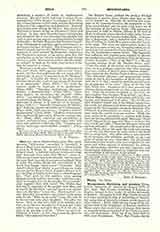

Mesa (Gr.,Mosa; Moabite Stone, MS` Heb., MYS`, meaning “deliverance” according to Gesenius), a King of Moab in the ninth century B.C., whose history is given in IV Kings, iii. He paid tribute to Achab, King of Israel, “a hundred thousand lambs and a hundred thousand rams with their fleeces” (verse 4). This seems to have been paid annually, and was possible since Moab was rich in pastures; accordingly Mesa is styled NQD), which, though left untranslated in the Greek text, means “sheep-owner” (Gesenius). After Achab‘s death Mesa refused to pay tribute, on which account Joram, King of Israel, Josaphat, King of Juda and the King of Edom entered into an alliance against him. They went by the southern route passing through an arid country, where they would have perished of drought, had not the prophet Eliseus miraculously supplied them with water. The ditches they had dug by command of the prophet were filled, and at sunrise the Moabites “saw the waters over against them red, like blood” (verse 22). Thinking their enemies had killed one another, they rushed to the camp with the cry “Moab to the spoils” (verse 23), only to be driven back with great slaughter. The allies followed. Mesa having tried, with seven hundred warriors, to cut his way through the besiegers and failed, took his eldest son, and upon the wall of the city, in sight of all, put him to death. “There was great indignation in Israel”, so that, for reasons not given in detail, “they departed from him”.
The Moabite Stone, perhaps the greatest Biblical discovery of modern times, throws some light on the period referred to. Through the learning and enterprise of M. Clermont-Ganneau, the inscription on the stone was published, and the stone itself is now one of the treasures of the Louvre, Paris. The monument, discovered in 1868 at Dhtban (Dibon) in the land of Moab, is of basalt, about three feet eight inches by two feet three inches and fourteen inches thick. It resembles a headstone, and is inscribed with thirty-four lines of writing, in which Mesa gives us the chief events of his reign. The stone was unfortunately broken by the Arabs as soon as they saw Europeans taking an interest in it; but squeezes had been taken previously, so that the inscription is almost intact. The fragments were collected, and missing parts supplied by plaster, the inscription on which was written from the squeezes. A writer in Smith’s “Dict. of the Bible” (s.v. MOAB), knowing nothing about the Moabite Stone, says: “From the origin of the nation and other considerations, we may perhaps conjecture that their language was more a dialect of Hebrew than a different tongue”. This conjecture the Moabite Stone makes a certainty. “The historical allusions and geographical names which we find in this inscription of Mesha tally so well with the O. T. that a suspicion could be aroused as to the genuineness of the stone” (Jour, of the Am. Or. Soc., XXII, 61). Suspicions have been aroused, but scholars almost unanimously set them aside as groundless. From the evidence furnished by the stone we may conclude that Josaphat, King of Juda, and Mesa, King of Moab, might have conversed, each in his own tongue, and understood each other. The old Phcenician character (found also in the Siloam inscription), the words, the grammatical forms and peculiarities of syntax in the two languages are nearly identical. The difference of pronunciation we cannot, of course, estimate since the vowels were not written. While the stone seems to be somewhat at variance with Scripture, yet the two substantially agree: Mesa says “Omri (Amri) King of Israel oppressed Moab”, mentions his own revolt and adds, “Chemosh (Chamos) delivered me from all kings”. He also describes his work of fortifying Moab, and as this made the north very strong, we see why the allies took the route south of the Dead Sea to attack him. The Bible hints at some disaster to the invaders, who withdrew suddenly on the very point of taking the city; while Mesa, like all Oriental monarchs in their records, may have magnified his victories and either omitted or minimized his defeats. The discrepancies therefore are only apparent, and chronological difficulties would be explained with better knowledge of the history of the period.
JOHN J. TIERNEY

